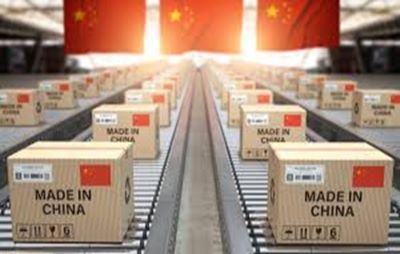Context-
In a recent Independence Day speech, the Indian Prime Minister encouraged states to compete with each other to attract investment, a strategy that contrasts sharply with China's current situation. China, once praised for its decentralised governance model that spurred rapid economic growth, is now experiencing the negative consequences of extreme subnational economic competition.
Extreme Decentralisation in China
● Unlike India, where local governments account for less than 3% of total government spending, China’s sub-provincial governments are responsible for a staggering 51% of government expenditures. These local governments also bear broader responsibilities, such as managing unemployment insurance and pensions, which are typically handled by national governments in other countries.
● However, despite this high level of decentralisation, China is not a federal country. In a federal system, lower-level governments have constitutionally protected powers that higher-level governments cannot revoke. In China’s Party-state system, such protections do not exist. Following Deng Xiaoping’s Southern Tour, which encouraged local governments to spend freely, the central government responded with the Tax-Sharing Reform of 1994, significantly restricting their ability to raise funds independently.
● Faced with restricted revenue-generating options, local governments in China turned to industrial construction as a means to boost regional economic growth and improve their political standing. They offered industrial land at significant discounts compared to residential land, aiming to attract investment and increase industrial outputs. This investment-led model, however, has a structural flaw: it inherently leads to overcapacity. It resembles a vehicle with two accelerators but no brakes—local governments aggressively pursued growth without considering the long-term sustainability of their actions.
● This approach initially succeeded, especially during the Hu Jintao period, when the central government set broad economic priorities and local governments were free to experiment with different growth strategies. This decentralised approach, often described as "crossing the river while feeling the stones," allowed localities to innovate and create wealth. However, it also resulted in significant structural overcapacity, wasteful investments, and loss-making enterprises.
Factors Sustaining Decentralised Growth
● Two key factors helped sustain this decentralised growth model in China. First, the central government’s directives were broad enough to allow local governments to pursue varied strategies to achieve national growth targets. For example, Guangdong province embraced economic liberalisation through special economic zones, while other regions explored alternative development models. This flexibility enabled local-level policy innovation without direct central intervention.
● Second, a favourable global geopolitical climate played a crucial role. During the early 2000s, foreign markets readily absorbed China’s increasing production capacity. The rapid expansion of China’s steel industry exemplifies this trend; within six years, China transitioned from being a net importer to the world’s largest steel producer and a net exporter. Although overcapacity eventually became a problem, the initial boom created significant economic value for local governments and companies.
● The model that had driven China’s rapid growth began to falter as Xi Jinping came to power. By 2014, researchers at the National Development and Reform Commission (NDRC) estimated that nearly half of all investments made between 2009 and 2013 were ineffective, resulting in a waste of about $6.9 trillion. In response, Xi Jinping’s administration sought to strengthen central control, establishing clearer guidelines to direct both state and private capital into sectors deemed important by the central government.
● Since then, central directives have become more specific and narrowly focused, particularly on achieving self-sufficiency in certain industries. For instance, the drive to localise the entire semiconductor supply chain was initiated without considering market-based demand or China’s comparative advantages. The “Big Fund” launched in 2014 aimed to build a self-sufficient semiconductor industry, prompting local governments to invest heavily in chip-making firms. Despite these efforts, China has not yet mastered the production of advanced chips, and many companies continue to rely on government funding without yielding significant results. According to The Economist, 30% of Chinese industrial firms were operating at a loss by mid-2024, surpassing the previous low during the Asian financial crisis in the late 1990s.
Geopolitical Challenges and the Belt and Road Initiative (BRI)
● China’s overcapacity has also raised concerns internationally, with many governments perceiving it as a national security threat. This is particularly evident in sectors such as electric vehicles and telecom equipment, where geopolitical tensions have intensified scrutiny of Chinese products. Moreover, China’s aggressive foreign policy has further damaged the global perception of its investments and products.
● To counter declining foreign demand, Xi Jinping’s administration attempted to boost domestic consumption and sought new markets through the Belt and Road Initiative (BRI). However, these strategies have not yielded the desired results. Increasing domestic demand proved challenging for a system accustomed to supply-side interventions, while the BRI has struggled due to the limited economic strength of participating countries.
China’s decentralised governance model, once celebrated as a cornerstone of its economic success, has now revealed significant drawbacks. Overcapacity and an overreliance on export-oriented growth are deeply ingrained in the Chinese system. As China’s international relations deteriorate and its push for self-reliance intensifies, the limits of its decentralised model have become increasingly apparent. While certain sectors may experience temporary export growth, China risks economic decline unless it rethinks its political and economic strategies, particularly its relationships with major global economies.
India should take note of China’s experience; decentralisation can drive economic growth, but without appropriate checks and balances, it can also lead to significant structural problems. The key lies in striking the right balance between local autonomy and central oversight to ensure sustainable and inclusive economic development.
|
Probable Questions for UPSC Mains Exam- 1. How did China's extreme decentralisation contribute to overcapacity, and why is this model now seen as counterproductive? (10 Marks, 150 Words) 2. What were the key changes introduced under Xi Jinping's leadership to address the inefficiencies of China's decentralised model, and what challenges have these changes encountered? (15 Marks, 250 Words) |
Source- The Hindu








